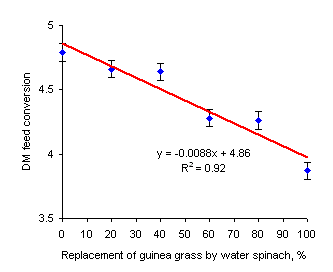| Workshop-seminar, 23-25 May, 2005, MEKARN-CTU |
Making Better Use of Local Feed Resources |
Water spinach (Ipomoea
aquatica) as replacement for guinea
grass for growing and lactating rabbits
Tran Hoang Chat, Ngo Tien Dung, Dinh Van Binh and T R Preston*
Goat and Rabbit Research Centre, Sontay, Hatay, Vietnam
binhbavi@netnam.vn
*UTA,
TOSOLY, AA #48, Socorro, Santander, Columbia
regpreston@utafoundation.org
Abstract
Forty-eight weaned rabbits (New Zealand white) with average initial weight of 1423g (growth trial) and thirty-six lactating rabbits (Improved New Zealand White) with average initial weights of 3460g in the third lactation were used in two experiments to evaluate water spinach as replacement of guinea grass as forage sources in a basal diet of concentrates and molasses block. The experiments were designed as completely randomized arrangements of 6 treatments which were: guinea grass replaced by water spinach at levels of: 0, 20, 40, 60, 80, 100 % based on dry matter. The experimental periods were 42 days (growth trial) and 75 days (gestation-lactation).
There was a linear response in growth rate and feed conversion, both of which were improved by the order of 25% (from 25 to 31 g/day for growth; 4.8 to 3.9 for feed conversion) as water spinach completely replaced the guinea grass. Similar positive improvements due to water spinach were observed in the lactation study with increases in all parameters (litter size and weight, milk yield and offspring growth rate).
It is concluded that water spinach is a highly appropriate feed for rabbits in view of its high protein content and low level of fibre.
Key words: Growth, lactation
Introduction
There is increasing interest in the potential role of water spinach (Ipomoea aquatica) as a protein-rich supplement for livestock in integrated farming systems. It was used successfully as a major protein supplement for sows in gestation and lactation (Le Thi Men and Bui Hong Van 1993)and for growing pigs (Prak kea et al 2004; Chhay Ty and Preston 2005). Recent results from Lao (Hongthong Phimmmasan et al 2004) and Cambodia (Pok Samkol et al 2005a,b) showed that rabbits grew at up to18 to 20 g/day when fed fresh water spinach as the sole diet.
The objectives of the present study were to evaluate water
spinach as a replacement for guinea grass on growth and reproductive performance
of rabbits fed a basal diet of concentrates.
Materials and methods
Two experiments were conducted at the Goat and
Rabbit Research Centre, Sontay, Hatay province, North Vietnam in
2004-2005
Experiment 1: Water spinach as replacement for guinea grass for growing rabbits
Treatments design and animals:
There were six levels of water spinach as replacement of guinea grass: 0, 20, 40, 60, 80, 100 (% DM basis). Forty-eight weaned rabbits (New Zealand White) with average initial weight of 1423 g were allocated to the experiment, and housed in individual cages to give 8 replications per treatment. The designed was a completely randomized arrangement of the treatments / replicates.with 8 replications.
Feeding and management
The basal diet was composed of a molasses block given at 2% (DM) of LW, a concentrate at 3% (DM) of LW and guinea grass/water spinach ad libitum. The feeds were in two equal amounts daily at 07.00h and 14.00h. Samples of feeds offered were taken weekly. Refusals were recorded daily and samples pooled on a weekly basis. Amounts of water spinach and guinea grass offered and refused were recorded separately for each component.
Measurements
The rabbits were weighed at the beginning and at seven day intervals over the trial period of 72 days. Samples of feeds offered and refused were analysed for DM, N and ash (AOAC 1990) and for NDF and ADF (Van Soest et al 1991).
Statistical analysis
Growth rates were calculated from the linear regression of live weight (y = g) on time (x=days). The data were analysed by the General Linear Model (GML) option of the ANOVA software of Minitab (Version Release 13.31). Sources of variation were: treatments (levels of water spinach) and error. Relationships between level of water spinach and measurements of intake and growth were analysed by regression using the Excel software of Microsoft Office 2003.
Experiment 2: Water spinach as replacement for guinea grass for reproduction and lactation of rabbits
Treatments, design and animals
Thirty-six lactating rabbits (New Zealand White) with average initial weight of 3460 g in the third lactation were allocated to the same diets as those in Experiment 1. The rabbits were in individual cages with 6 replications of each treatment n a completely randomized arrangement.
Feeding and management
This was the same as in the growth trial.
Measurements
Recording and sampling of feeds and their chemical analysis were
the same as in the growth trial. The does were weighed at
parturition and at weaning. The litters were weighed at birth, at
21 days and at 30 days (weaning). Milk yield of the does was calculated from
the formula proposed by Lebas et al (1986):
Statistical analysis
This was the same as in the growth trial.
Results and discussion
There were major differences between the guinea grass and the water spinach with the latter having twice the crude protein content and only about one third of the level of NDF and ADF (Table 1).
| Table 1: The chemical composition of dietary ingredients (means ± SEM) | ||||
|
|
Guinea grass |
Water spinach |
Concentrate |
MB* |
| DM, % |
21.3±0.66 |
13.2±0.16 |
87.5±0.69 |
78.0±0.35 |
| As % of DM |
|
|
|
|
|
Crude protein |
10.2±0.21 |
21.9±0.67 |
16.0±0.9 |
8.4±0.25 |
| Ash |
8.1±0.12 |
16.3±0.21 |
3.5±1.0 |
- |
| NDF |
61.2±1.98 |
19.7±0.12 |
9.7±0.2.3 |
- |
| ADF |
40.1±1.22 |
15.6±0.19 |
6.7±0.12 |
- |
*MB: Molasses: 37%; Cassava root meal: 23%; Rice bran: 20%; Clay: 10%; Soya bean meal: 10% |
||||
Growth trial
The intake of dry matter was similar on all treatments, however, crude protein was increased in proportion to the content of water spinach in the diet (Table 2). The intake of the forage component was approximately 50% of the total diet (Figure 1).
|
Table 2: Mean values for intake of dietary components |
||||||
|
|
Water spinach replacingGuinea grass (% DM basis) |
|||||
|
0 |
20 |
40 |
60 |
80 |
100 |
|
|
Feed intake, g/day |
|
|
|
|
||
|
Guinea grass DM |
54 |
37.8 |
26.9 |
19.9 |
12.8 |
0 |
|
Water spinach DM |
0 |
17.2 |
29.9 |
38.4 |
44.5 |
50.5 |
|
Concentrate DM |
39.4 |
39.4 |
39.1 |
39.8 |
40.6 |
40.5 |
|
MB DM |
29.9 |
28.6 |
31.1 |
26.4 |
25.8 |
29.8 |
|
Total DM |
123.5 |
123.2 |
127.1 |
124.5 |
123.7 |
120.8 |
|
Crude protein |
16 |
17.6 |
19.1 |
20.8 |
20.8 |
21 |

Figure 1: Effect of replacing guinea grass
with water spinach
on feed intake of growing rabbits
There was a linear response in growth rate and feed conversion, both of which were improved by the order of 25% as water spinach completely replaced the guinea grass (Table 4 and Figures 2 and 3). The observed growth rates were higher than were reported by Hongthong Phimmmasan et al (2004) (18 g/day) in Lao and by Pok Samkol et al (2005a,b) in Cambodia (14 and 20 g/day, respectively). However, in the studies in Lao and Cambodia the water spinach was the sole component of the diet and the rabbits were probably of inferior genetic capacity for growth as they were from unimproved New Zealand White crosses with local breeds. By comparison the rabbits used in the present study were the progeny of an improved New Zealand White breed imported from Hungary.
|
Table 3: Effect of replacement of guinea grass w ith water spinach on live weight gain (LWG) and feed conversion ratio (FCR) of growing rabbits |
||||||
|
|
Water spinach replacingGuinea grass (% DM basis) |
|||||
|
0 |
20 |
40 |
60 |
80 |
100 |
|
|
Live weight, g |
|
|
|
|
|
|
|
Initial |
1390 |
1443 |
1413 |
1403 |
1473 |
1420 |
|
Final |
2462 |
2571 |
2557 |
2587 |
2705 |
2740 |
|
Daily gain |
25.5 |
26.9 |
27.2 |
29.2 |
29.3 |
31.4 |
|
DM feed conversion |
4.79 |
4.66 |
4.64 |
4.28 |
4.26 |
3.87 |
|
|
|
|
Figure 2: Effect of replacing guinea grass with water
spinach on live weight gain of growing rabbits |
Figure 3: Effect of replacing guinea grass with water
spinach on DM feed conversion of growing rabbits |
Reproduction
Feed intake
The main effect of replacing guinea grass with water spinach was to increase the protein intake (Table 2).
|
Table 3: Mean values for intake of dietary components (lactation) |
|||||||
|
|
Water spinach replacingGuinea grass (% DM basis) |
||||||
|
0 |
20 |
40 |
60 |
80 |
100 |
||
|
Feed DM intake, g/day |
|
|
|
|
|||
|
Guinea grass |
65.1 |
49.1 |
33 |
21 |
18.1 |
0 |
|
|
Water spinach |
0 |
17.9 |
36 |
49 |
66.4 |
81.2 |
|
|
Concentrate |
73 |
72.6 |
71 |
70 |
71.7 |
70.8 |
|
|
MB* |
56.2 |
56.7 |
57 |
56 |
51.7 |
49.6 |
|
|
Total |
194 |
196 |
197 |
196 |
208 |
201 |
|
|
Crude protein, g/day |
25.7 |
28 |
30 |
32 |
34.5 |
34.6 |
|
Litter size and performance
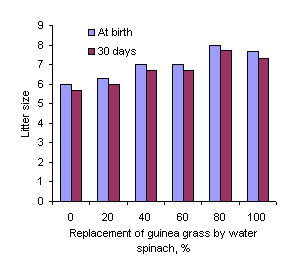 |
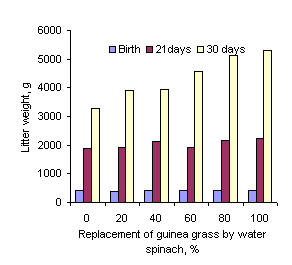 |
| Figure 3: Effect on litter size of replacing guinea grass with water spinach in the diet of the does and the litter | Figure 4: Effect on litter weight of replacing guinea grass with water spinach in the diet of the does and the litter |
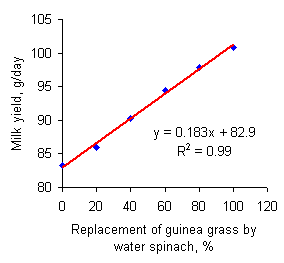 |
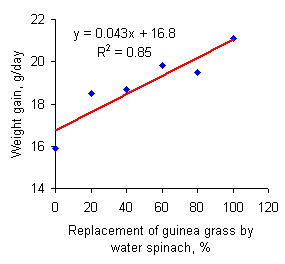 |
| Figure 5: Effect on doe milk yield of replacing guinea grass with water spinach in the diet of the does and the litter | Figure 6: Effect on weight gain of the litter by replacing guinea grass with water spinach in the diet of the doe and the litter |
|
Table 4: Effect of replacement of guinea grass with water spinach on weight change and milk yield of the doe mother and size and growth of the litter |
||||||
|
|
Water spinach replacingGuinea grass (% DM basis) |
|||||
|
0 |
20 |
40 |
60 |
80 |
100 |
|
|
Live weight of does, g |
|
|||||
|
Initial |
3 400 |
3 570 |
3 400 |
3 430 |
3 500 |
3 470 |
|
Final |
3 660 |
3 900 |
3 730 |
3 900 |
3 967 |
3 760 |
|
Weight change |
267 |
333 |
333 |
566 |
466 |
300 |
|
|
|
|
|
|
|
|
|
Milk yield, g |
83.2 |
86 |
90.2 |
94.4 |
97.8 |
101 |
|
|
|
|
|
|
|
|
|
Litter size |
|
|
|
|
|
|
|
At birth |
6 |
6.3 |
7 |
7 |
8 |
7.67 |
|
30 days |
5.7 |
6 |
6.7 |
6.7 |
7.7 |
7.3 |
|
|
|
|
|
|
|
|
|
Survival rate, % |
95.2 |
95.8 |
96.3 |
95.2 |
96.3 |
96.3 |
|
|
|
|
|
|
|
|
|
Weight of litter, g |
|
|
|
|
|
|
|
At birth, g |
403 |
399 |
420 |
402 |
436 |
435 |
|
At 21 days |
1883 |
1930 |
2125 |
1903 |
2177 |
2230 |
|
At 30 days |
3267 |
3900 |
3933 |
4567 |
5133 |
5300 |
|
Daily gain (0-20d) |
15.9 |
18.5 |
18.7 |
19.8 |
19.5 |
21.1 |
There appear to be no comparable data in the literature on feeding fresh water spinach to pregnant and lactating rabbits. However, recent observations in Lao (Chhay Ty, personal communication) are supportive of the high nutritional value of water spinach as a feed for pregnant rabbits. :Rabbits fed through gestation and lactation on diets composed mainly of water spinach (elephant grass and stylosanthes foliage were also freely available but contributed less than 10% of the diet) gave birth to litters of 5.6±2.7 offspring weighing 272±114 g (means and SD). While these results are inferior to those reported in the present study, there were the same differences in breed makeup, added to the fact that in the Lao study the rabbits were in their first pregnancy compared with the 3rd pregnancy in the present study.
Conclusion
-
Fresh water spinach foliage was 25% superior to guinea grass in supporting growth and lactation performance of rabbits when offered ad libitum (contributed about 50% of the diet DM) as a supplement to fixed amounts of concentrates (fed 3% of LW) and a molasses block (2% of LW).
Acknowledgments
The authors wish to thank the MEKARN project, financed by Sida/SAREC, for supporting this research.
References
AOAC 1990 Official methods of analysis. Association of Official Analytical Chemists. 15th edition. Arlington pp1290
Hongthong Phimhttp://www.mekarn.org/sarpro/lemen.htmmmasan, Siton Kongvongxay, Chhay Ty
and Preston T R 2004: Water spinach (Ipomoea
aquatica) and Stylo 184 (Stylosanthes
guianensis CIAT 184) as
basal diets for growing rabbits.
Le Thi Men, Ogle B and Vo Van Son 2000 Evaluation of water spinach as a protein source for BaXuyen and Large White sows. Proceedings National Workshop-Seminar Sustainable Livestock Production on Local Feed Resources (Editors: T R Preston and R B Ogle).
Ho Chi Minh City, Vietnam, January 18-20th 2000. Retrieved June 7, 2005 from
http://www.mekarn.org/sarpro/lemen.htm
Pok Samkol, Preston T R and Ly J 2005a Performance traits of growing rabbits given graded levels of broken rice and water spinach (Ipomoea aquatica) ad libitum. Livestock Research for Rural Development. (in preparation)
Pok Samkol, Preston T R and Ly J 2005b Effect of increasing offer level of water spinach (Ipomoea aquatica) on intake, growth and digestibility coefficients of rabbits. Livestock Research for Rural Development. (in preparation)
Prak Kea, Preston T R and Ly J

